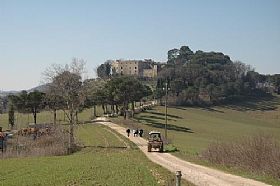Perugia

Perugia is cosmopolitan and unforgettable, and is also the largest walled medieval city in Italy. Situated on a hill overlooking the gorgeous expanses of Val d'Umbria, it is a great home base for exploring Umbria and southern Tuscany. The city's vibrant life, cultural offerings, beautiful atmosphere and laid-back feel are very appealing. Enjoy the medieval lanes of arches, stairways and mysterious alleys. Grand churches may look bland on the outside, but house impressive and renowned artwork inside. The bustling University for Foreigners attracts an international crowd and animates the place.
The first inhabitants were the Umbrians, an ancient Italic tribe that was displaced by the Etruscans in the 6th-century BC. It quickly became one of the most important Etruscan cities. Later on, the Romans subdued the local population and grew. Roman Perusia stayed loyal to Rome during the Punic Wars and helped them win the famous Battle of Lake Trasimeno, but after the decline of the Roman Empire, the city was ruled over by a succession of brutal overlords. In the Middle Ages it sided with the Guelphs, vascillated between the Papal States and Tuscan rulers, but despite the instability grew and was enriched with great artistic and architectural treasures. Perugia fell in the hands of Austria and later France, under Napoleon.
Architecture lovers will revel in an array of gorgeous buildings spanning several centuries. Stunning cathedrals, churches and various public buildings will leave you breathless, while art lovers will see why Pietro Vannucci is better known as Perugino; his masterpieces are viewable around the city, along with some by his famous student, who surpassed his master-Raphael.
Don't miss Palazzo dei Priori, built between 1293 and 1297, and expanded times; it is said to be a superb expression of the soul of the city. On the Corso Vannucci side, the Palazzo is adorned by a marvelous portal decorated with the symbols of Perugia and the Guelphs: the griffon and the lion. From that portal you can enter the National Gallery of Umbria, with its acclaimed collection of Umbrian art, including Perugino's paintings, and works by Pinturricchio, Fra Angelico and others.
The city's main drag has always been the Corso, now named for Pietro Vannucci. Along its length you'll find epic palaces and renowned buildings that have participated in the city's history and infamy. The pedestrianized street is the place to enjoy a stroll, look in the shops, enjoy a drink while people watching and gape at the architecture. HEre you'll find the Collegio del Cambio, Collegio della Mercanzia, Palazzo dei Notari, Casa di Baldo degli Ubaldi, Church of S. Isidoro (deconsacrated), Palazzo Donini and more. The city's monumental gateway opened onto this street and the Corso has never lost its importance throughout the ages. Porta Sant'Angelo is the city's most impressive and massive gates. Take a walk onto the Roman Aqueduct along Via Acquedotto, or for a fun silly game, go to Piazza Italia under the portal of the provincial building and try out the Whispering Arches. Stand at diagonal opposite corners of the arches and whisper to each other, you'll hear the other loud and clear!
Perugia's most famous event is its summer Jazz Festival, a full blow-out homage to the music form that brings in headline musicians from around the world. The other famous festival is Euro Chocolate, here in the hometown of Perugina Chocolate, with artisan producers still proudly turning out decadent confections, this festival every autumn highlights all things chocolate. The Sagra of the Tartufo Nero is the foodies delight, held every July in the nearby town of Ripa, dedicated to foods created with the area's prized black truffle, accompanied by music, dancing and games.
See our Travel Guide for an array of churches and sights around Perugia. The city is ideally situated along the border with Tuscany, near Lake Trasimeno, Assisi, Spello and Citta della Pieve in Umbria, but close to Arezzo, Cortona, Montepulciano and Pienza in Tuscany.
Have a look at our vacation villas in Perugia.

 Amalfi Coast
Amalfi Coast Sorrento Coast
Sorrento Coast Tuscany
Tuscany Cilento National Park
Cilento National Park Lake Como
Lake Como Rome and Latium
Rome and Latium Umbria
Umbria Capri and Ischia
Capri and Ischia Venice
Venice Puglia (Apulia)
Puglia (Apulia) Liguria
Liguria Sicily
Sicily Lake Maggiore
Lake Maggiore Lombardy
Lombardy Sardinia
Sardinia Lake Garda
Lake Garda Abruzzo and Marche
Abruzzo and Marche Calabria
Calabria

